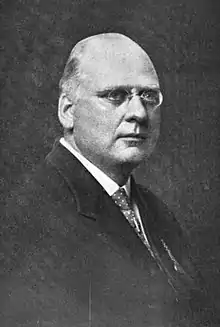Herbert Quick
John Herbert Quick (October 23, 1861 – May 10, 1925) was an American writer and politician.
Herbert Quick | |
|---|---|
 | |
| 27th Mayor of Sioux City, Iowa | |
| In office January 1, 1898 – January 1, 1900 | |
| Preceded by | J. M. Cleland |
| Succeeded by | A. H. Burton |
| Personal details | |
| Born | John Herbert Quick October 23, 1861 Steamboat Rock, Iowa, U.S. |
| Died | May 10, 1925 (aged 63) Columbia, Missouri, U.S. |
| Spouse | Ella Corey |
| Occupation |
|
Biography
Born October 23, 1861, near Steamboat Rock, Grundy County, Iowa, to Martin and Margaret Coleman Quick, he was afflicted with polio as a child. He married Ella Corey in 1890.[1]
Quick established a law firm in Sioux City, where he practiced for 19 years.[2] He also became a businessman and later served as the 27th Mayor of Sioux City, Iowa from 1898 to 1900.[3] An historical marker, Herbert Quick Ravine, can be found in Sioux City. The plaque reads "Named in Memory of Herbert Quick. Statesman, Writer, Mayor of Sioux City. He Knew and Loved the Prairie's of Iowa, 1861-1925."[4]
His best known works are the Midland Triology of Vandemark's Folly (1922), The Hawkeye (1923), and The Invisible Woman (1924).[5] The fictional stories describe the life of an Iowa pioneer.[5]
An early environmentalist, his best known non-fiction work was On Board the Good Ship Earth (1913). He also wrote an autobiography, One Man's Life (1925).[5]
Quick's 1906 comic novel, Double Trouble, or, Every Hero His Own Villain was the basis for a 1915 silent film produced by D.W. Griffith, directed by Christy Cabanne, and starring Douglas Fairbanks in one of his earliest film roles.[6]
Quick died on May 10, 1925, in Columbia, Missouri.[7]
Legacy
The John Herbert Quick House was listed on the National Register of Historic Places in 1984.[8][9][10] The Herbert Quick Schoolhouse, a historical, one-room schoolhouse, is in Grundy Center, Iowa. [11]
References
- Longden, Tom (November 24, 2002). "Quick Biography". Des Moines Register. p. B.1. Retrieved October 23, 2011.
- "Famous Iowans, Hubert Quick". Des Moines Register. Archived from the original on July 12, 2019. Retrieved July 12, 2019.
- "Herbert Quick". IMDb.
- VanSteenwyk, Ruth (November 19, 2019). "Herbert Quick Ravine Historical Marker".
- K., A. G. (December 1926). "Reviewed Works: Vandemark's Folly, The Hawkeye, The Invisible Woman, One Man's Life". American Speech. Duke University Press. 2 (3): 153–155. JSTOR 452465. Retrieved September 18, 2023.
- John T. Soister (2012). American Silent Horror, Science Fiction and Fantasy Feature Films, 1913-1929. McFarland. pp. 158–160. ISBN 978-0-7864-8790-5.
- "Herbert Quick Dies After Brief Illness". The Charlotte Observer. Columbia, Missouri. May 11, 1925. p. 14. Retrieved July 23, 2020 – via Newspapers.com.
- "National Register Information System – Quick, John Herbert, House (#84003639)". National Register of Historic Places. National Park Service. March 13, 2009. Retrieved August 11, 2023.
- "National Register of Historic Places, West Virginia - Morgan County, Quick, John Herbert, House".
- "Coolfont Manor House". Washington Heritage Trail.
- "Celebrating 150 years of history: Rededication ceremony to be held at Herbert Quick Schoolhouse". The Grundy Register. September 25, 2019.
- Bogue, Allan G. (April 1973). "Herbert Quick's Hawkeye Trilogy". Books at Iowa. 16: 3–13. doi:10.17077/0006-7474.1336. Retrieved August 18, 2021.
External links
- Works by Herbert Quick at Project Gutenberg
- Works by or about Herbert Quick at Internet Archive
- Vandemark's Folly by John Herbert Quick' at Project Gutenberg
- Herbert Quick at Library of Congress, with 26 library catalog records